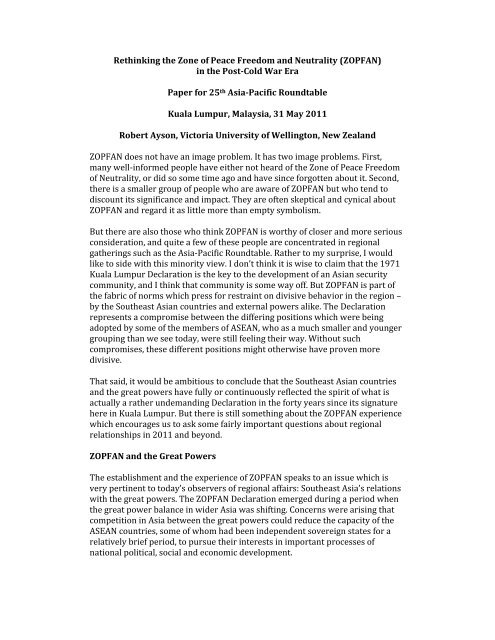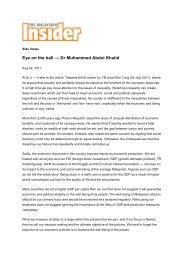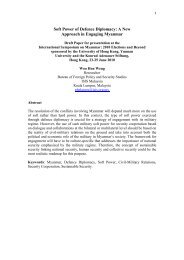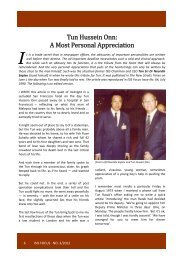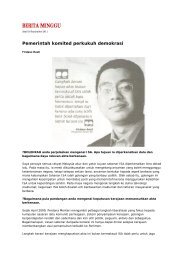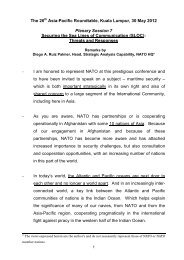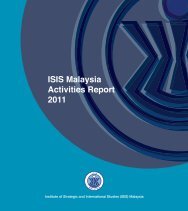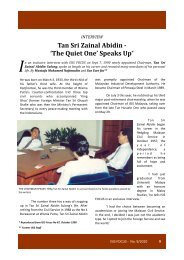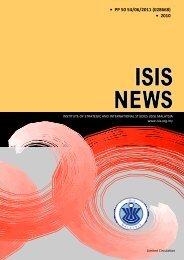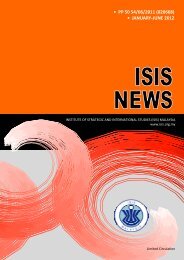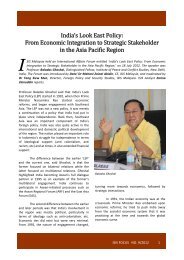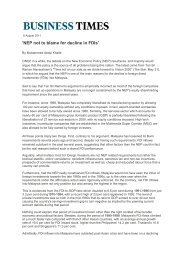ZOPFAN - ISIS Malaysia
ZOPFAN - ISIS Malaysia
ZOPFAN - ISIS Malaysia
Create successful ePaper yourself
Turn your PDF publications into a flip-book with our unique Google optimized e-Paper software.
Rethinking the Zone of Peace Freedom and Neutrality (<strong>ZOPFAN</strong>)<br />
in the PostCold War Era<br />
Paper for 25 th AsiaPacific Roundtable<br />
Kuala Lumpur, <strong>Malaysia</strong>, 31 May 2011<br />
Robert Ayson, Victoria University of Wellington, New Zealand<br />
<strong>ZOPFAN</strong> does not have an image problem. It has two image problems. First,<br />
many well‐informed people have either not heard of the Zone of Peace Freedom<br />
of Neutrality, or did so some time ago and have since forgotten about it. Second,<br />
there is a smaller group of people who are aware of <strong>ZOPFAN</strong> but who tend to<br />
discount its significance and impact. They are often skeptical and cynical about<br />
<strong>ZOPFAN</strong> and regard it as little more than empty symbolism.<br />
But there are also those who think <strong>ZOPFAN</strong> is worthy of closer and more serious<br />
consideration, and quite a few of these people are concentrated in regional<br />
gatherings such as the Asia‐Pacific Roundtable. Rather to my surprise, I would<br />
like to side with this minority view. I don’t think it is wise to claim that the 1971<br />
Kuala Lumpur Declaration is the key to the development of an Asian security<br />
community, and I think that community is some way off. But <strong>ZOPFAN</strong> is part of<br />
the fabric of norms which press for restraint on divisive behavior in the region –<br />
by the Southeast Asian countries and external powers alike. The Declaration<br />
represents a compromise between the differing positions which were being<br />
adopted by some of the members of ASEAN, who as a much smaller and younger<br />
grouping than we see today, were still feeling their way. Without such<br />
compromises, these different positions might otherwise have proven more<br />
divisive.<br />
That said, it would be ambitious to conclude that the Southeast Asian countries<br />
and the great powers have fully or continuously reflected the spirit of what is<br />
actually a rather undemanding Declaration in the forty years since its signature<br />
here in Kuala Lumpur. But there is still something about the <strong>ZOPFAN</strong> experience<br />
which encourages us to ask some fairly important questions about regional<br />
relationships in 2011 and beyond.<br />
<strong>ZOPFAN</strong> and the Great Powers<br />
The establishment and the experience of <strong>ZOPFAN</strong> speaks to an issue which is<br />
very pertinent to today’s observers of regional affairs: Southeast Asia’s relations<br />
with the great powers. The <strong>ZOPFAN</strong> Declaration emerged during a period when<br />
the great power balance in wider Asia was shifting. Concerns were arising that<br />
competition in Asia between the great powers could reduce the capacity of the<br />
ASEAN countries, some of whom had been independent sovereign states for a<br />
relatively brief period, to pursue their interests in important processes of<br />
national political, social and economic development.


